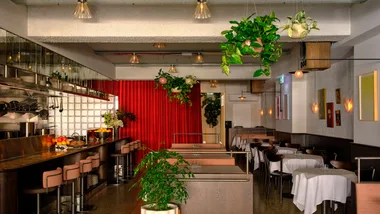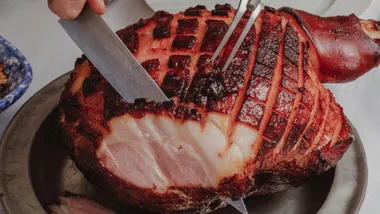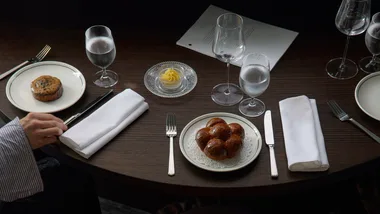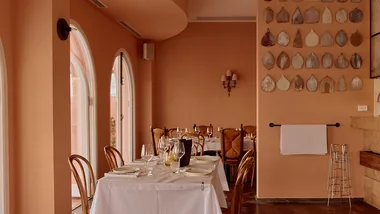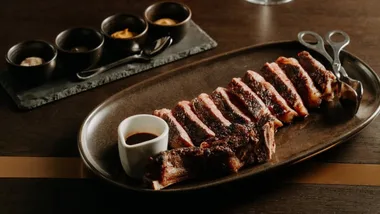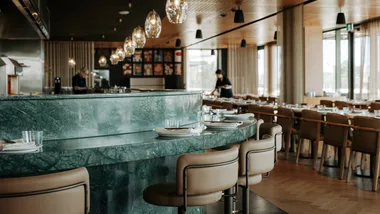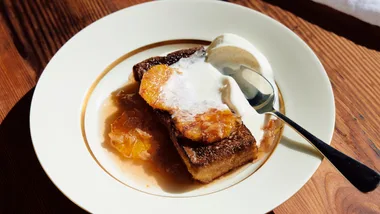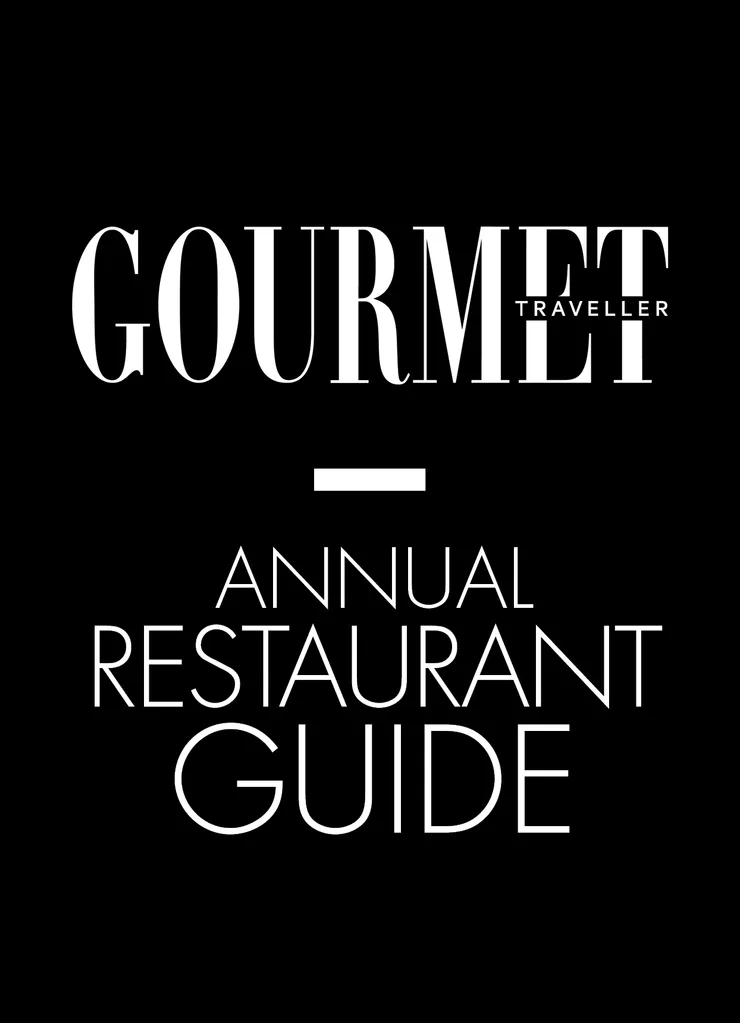Marque
4-5/355 Crown St, Surry Hills, NSW,
(02) 9332 2225.
Licensed
Cards AE DC MC V
Lunch Friday noon-2.30pm; dinner Mon-Sat 6.30pm-10.30pm.
Price Entrées $28, main courses $48, desserts $24;degustation $145.
Noise Pleasant.
Wheelchair access No.
Plus One of the most compelling and edgy food and wine packages in the country.
Minus The food can be challenging at times; the music sucks.
Meet Mark Best, the pragmatic fantasist. He’s the guy who still has the pliers he bought as an apprentice electrician working in the mines 200 clicks south of Kalgoorlie and 4000 feet underground, only today he uses them to adjust the knob on the slicer his kitchen uses to make paper-thin sections of bluefin tuna and abalone. He’s the straight-talking guy from Murray Bridge, South Australia who chucked in the gaffer tape, insulated screwdrivers and wire strippers when he got his first taste of service in a restaurant. The chef who came late to cooking, whose rise to public acclaim was more gradual than glamorous, but a chef who has become a compelling figure to both dyed-in-the-wool diners and aspiring young cooks alike. Building on years of continuous evolution with the support of strong teams both front- and back-of-house, and with the extra lustre that a subtle refurbishment can give, Marque, the restaurant at which Best has plied his trade since 1999, has cemented its place among the very finest restaurants in this country.
Then again, at one moment in its extraordinary degustation menu, I was strongly tempted to remove the fork from my mouth with the food still on it and see if there was somewhere I could hide it, Mr Bean-like, under the table. The dish in question is one of those pretty little Pacifics farmed in Coffin Bay and marketed as virgin oysters. I can’t vouch for its innocence, but it was in very good nick. It’s just that the ‘grilled sea foam’ it was topped with – a pickling liquor of vinegar, water and oyster liquor mixed with enough of a sucrose derivative to allow it to be whipped and then blowtorched – didn’t agree with me. I didn’t think it was a winning combination, but the rest of the table were rapt, one of my fellow diners going so far as to say it made her think of being dumped in the surf and swallowing a fish – in a good way.
Later, amid the 18 or so jewel-like and sparkling courses, the tables were turned. Out came a crab ‘custard’. It was covered with a small blizzard of ice crystals made of foie gras, an effect achieved, I presume, with the use of a Pacojet (a device not unlike a very fancy blender that can shave frozen foodstuffs very finely, usually for the purposes of making sorbets or ice-creams). I thought the fine-dust delivery of the foie intensified its creaminess and richness beautifully. To the others, it was just so much frozen dead duck liver.
Such is the challenge presented by Marque. For the most part, the food is very, very impressive indeed. When things don’t gel, though, it’s because the kitchen takes risks, not because of any failure to surmount technical challenges or because of the use of anything less than good produce. It’s a matter of taste. The restaurant embraces the future, but keeps its feet on the ground with details like grand cru butter and darkly crusted house-baked bread. The chaud-froid egg, a dish Best picked up during a stage at Alain Passard’s legendary L’Arpège in Paris, is a wonderful silken confection of a gently poached egg yolk presented in a neatly decapitated eggshell, touched with chives, salt and maple syrup, topped with chilled cream, but it’s also served with the nicest breadsticks.
Best says his second epiphany came when he and his wife Valerie were driving around France in 1996 on holiday and happened to eat at L’Arpège. When the couple went back to Sydney to open Peninsula, their well-liked Balmain bistro, the meal “stuck in the back of my mind as a constant source of dissatisfaction,” Best says. An image of just how good things could be. The Bests sold Peninsula and Mark scored a stage working in the kitchen at L’Arpège for a little over four months. It was a tough slog. Best says he would pay the 10 francs admission at the nearby Auguste Rodin Museum each afternoon just so he could get some kip in the gardens. But he also learned a tremendous amount, from rock-solid technique and core recipes to a philosophy of always looking for a better way to do things. After spending time working for Raymond Blanc at Le Manoir Aux Quat’ Saisons in Oxfordshire, he returned to Sydney and worked as Guillaume Brahimi’s sous at Bilson’s while looking for a site, and then opened Marque in 1999. Things have been on the up ever since.
Late June this year saw the room refitted. It’s not a dramatic structural rethink, yet the changes have certainly given it a lift. A double set of doors gives more distance from Crown Street’s passing parade. It’s a little bigger inside now, and the space is moodily picked out in matte and gloss blacks, with touches of marble and the zinc bar for relief. Linen and wares are luxe, but not showily so.
Don’t hesitate in ordering the degustation. The à la carte option has its riches, of course. The ‘tuna on toast’, for instance, is certainly one of the dishes of the year – a piece of raw fish draped sensuously across fluffy brioche, with a smear of foie gras custard to bind it and a shower of crunchy pork crackling dust for textural interest. But something about this style of food suits the degustation mode down to the ground, and of the almost 20 dishes I looked at last, 12 were superb, eliciting oohs and ahhs, and at least five were outright conversation-stoppers. This strike rate is unusually good, even at the international three-star level. Sommelier Peter Healy holds things to a similar standard with the wine, too. The list at Marque has long been at least as strong a draw as the food, and Nick Hildebrandt, now sommelier/co-owner of Bentley Restaurant & Bar a few blocks up Crown Street, built a strong foundation in the years he managed it. Best is adamant than any wine on the list has to stand on its own intrinsic merits. “You won’t find verticals of anything,” he says. “You won’t find a page of Henschke or any sponsored page. Commercially, we’re not as savvy as our competitors. We do enough to hang in there and make a modest living, but we are pretty idealistic about things, and remain so.”
One of the later courses, rare pieces of roast squab paired with zephyrs of thinly sliced greenlip abalone and chocolate feuilletage, like slightly bitter leaves of the driest possible puff pastry, teamed with a glass of Agly Brothers 2005 Syrah/Grenache from the Côtes du Rousillon, is quite probably the finest thing I’ve eaten this year anywhere. With a little celeriac purée in there for lubrication, it’s a near-perfect play of textures and flavours that surrenders new pleasures with each bite.
Elsewhere on the menu you’ll encounter the shock of biting into the crisp shell of edible white clay encasing tiny Nicola potatoes on mayo thick with fresh black Manjimup truffle, inspired by Spain’s Mugaritz. The delight of beetroot and foie gras macaroons that burst like tiny bubbles on the tongue. You’ll marvel at a cheese course of Bleu de Moncenis, a cow’s milk blue, layered with apple jelly, the crunch of mustard seeds supplanting the usual bread or biscuit component. At various other points you’ll find Campari-flavoured bonbons, calamari cut to resemble risotto, and a construction of fine slices of slow-cooked octopus dressed with petals of marigold and a stained-glass-window-like arrangement of crisp potato discs that is as close to pretty as octopus is likely to get.
Desserts tend to the unusual, whether it’s warm chocolate ganache with praline, lemongrass and rosemary (paired with an equally quirky blend of rare Rutherglen muscat and ginger beer that Peter Healy concocts himself), or the caramelised tomato ‘stuffed with 12 flavours’ of finely diced dried and fresh fruits, with star anise ice-cream, an Alain Passard dish that has become something of a Marque staple. I’m sure I risk being labelled a philistine in doing so, but I have to declare that few desserts I’ve had at the restaurant, superb as they are, come close to matching the little saucer of caramelised Sauternes custard long served as a pre-dessert in the pure, spoon-licking pleasure stakes.
The prix fixe at lunch, a recent introduction, is a good way to get a taste of what’s going on here without commiting to the whole $145 hog. The room takes on a different character by day, its sheer curtains shimmering. A mere $45 buys you three courses plus the chaud-froid egg as an amuse. This week, it’s a tartare of Petuna ocean trout with green apple, hazelnut mousse and black rice, followed by lamb shoulder roasted in hay and then cumquats poached in syrup on Génoise with yoghurt sorbet and honey powder. Beware the wine list. It’s dangerously tempting. While there are many wines listed that are approchable in price, Healy has also been thoughtful enough to list Clonakilla Shiraz-Viognier and Champagne Devaux by the glass, which could potentially be expensive for the weaker-willed. Marque’s list is also one of the few I’ve seen offering a $65 Champagne by the flute. Consider yourself duly warned.
This is a restaurant in its element. Mark Best has long been something of a dark horse in the top-chef pack, but far from seeing his ambition dimmed or his creative edge dulled, this quiet achiever is steadily pulling into the lead. He’s certainly selling some of the most interesting food and wine you’re likely to find in Australia right now. “It’s a slower process,” Best says of his less-than commercial approach, “and I think it keeps you pretty humble, but career-wise I’m very satisfied.”
 Amanda Mclauchlan
Amanda Mclauchlan
